Today’s post is a guest article written by Mike Burns, taking a look at one of the S&W revolver copies made in Eibar for the French military. He compares it to a WWI .455-caliber S&W Hand Ejector and a WWII .38-caliber S&W Military & Police revolver. Thanks, Mike!
Short Background
This is intended to be a technical article, however a brief potted history to set the stage is appropriate.
Once it was clear that the first world war would go on for some time, the French government needed to find alternative sources of handguns to supplement the “modern” Model 1892 Saint-Etienne revolvers, often mis-named “Lebel” revolvers, and the older Model 1873 revolvers still in service. To avoid supply issues, the French insisted that revolvers offered must chamber their 8mm M92 revolver cartridge. This cartridge propelled a 120gn .330” jacketed bullet at about 740fps, which by British and American standards is anaemic.
To respond to this need, many gunmakers in the Eibar valley in the Basque Country, started producing revolvers for the French. Since Smith & Wesson and Colt’s patent protection did not extend to Spain in that period, these makers had long been producing local versions of American revolvers, including the Smith & Wesson topbreaks, the solid-frame M&P, Colt New Model Army & Navy, and the Colt Police Positive.
The French government chose local versions of the Smith & Wesson M&P, of which the firms of Trocaola Aranzabal Y Cia, Garate y Anitua & Cia, Orbea Hermanos and others already had experience. In French service these were referred to as “Modèle 92 espagnols” – “Spanish Model 92s”, presumably making reference to the calibre designation, or indicating that they were a substitute standard to the “real” Model 92’s. Interestingly enough, the British government also purchased numbers of topbreak S&W clones in .455 Webley at the same time, although these appear to have been relegated to a training role.
The Revolver
This particular revolver is from Trocaola, and is in about 80% exterior condition with holster wear. However, the barrel and cylinder interiors look like it has hardly been fired.
To compare with a Smith and Wesson of the period, we shall look at how this revolver differs mechanically and in its construction from a Smith and Wesson Hand Ejector in .455 Webley of WW1 manufacture. For a general external appreciation, we’ll also compare with a late-WW2 commercial M&P in British configuration in .38 S&W calibre with a 5” barrel. This particular M&P is a whole story in and of itself, but that’s for another time.
Are these revolvers junk, as many claim? Let’s have a look at them from an engineering, design and practical perspective.
So, to start off, here’s the three revolvers:
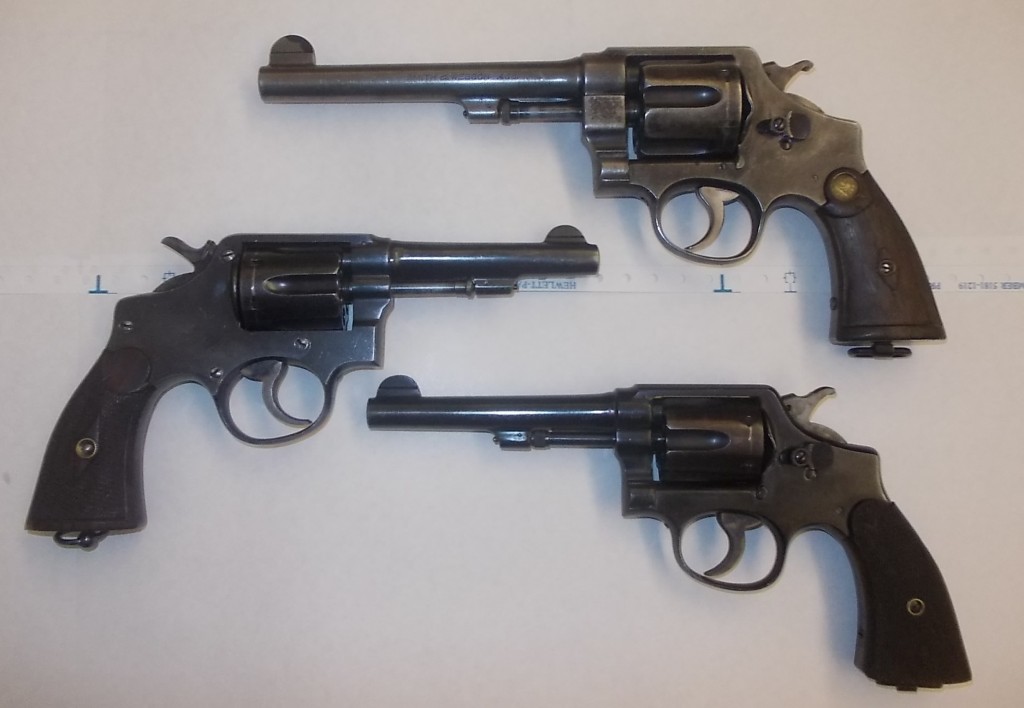
The relationship between the designs is obvious, right down to the end of the ejector rod, which is very much of the period and was later changed as you can see from the M&P. Barrel length is 11cm (4 1/3 inches), a practical length for a military revolver which makes the 16.5cm (6 1/2 inches) of the Hand Ejector look frankly ridiculous.
The finish is somewhat thin, although there are some dings on the surface which have not removed the bluing. The first difference for economy is that the frame behind the trigger guard is not as rounded as the S&W, eliminating some machining here.
Since we’re still dealing with the outside aspects, let’s have a look at the sight pictures:
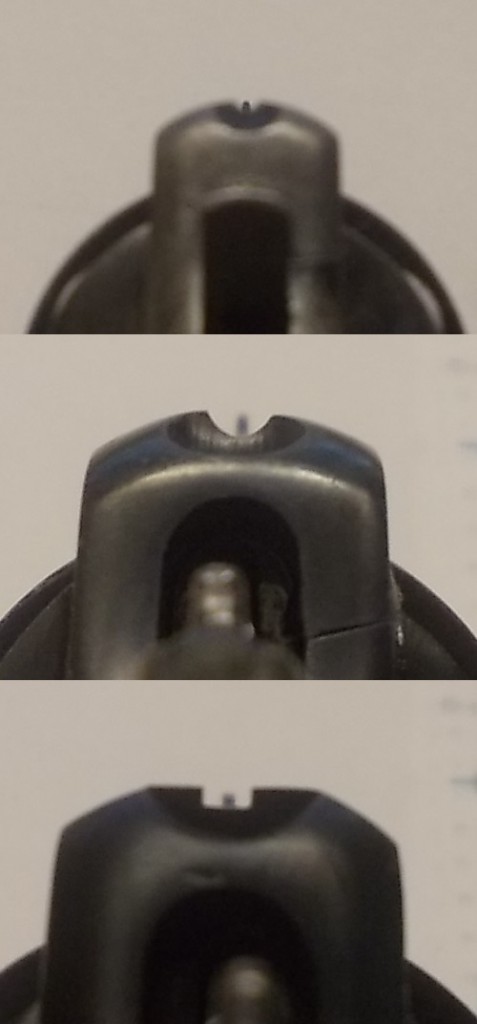
For the period, the Trocaola’s sights are excellent: well-proportioned for combat shooting, unlike the impractically-fine sights on the Hand Ejector. My only complaint is that the notch could be deeper and possibly squarer, like the M&P.
Another external aspect that is interesting is the shape of the cylinder latch, which is deeply curved and very heavily chequered.
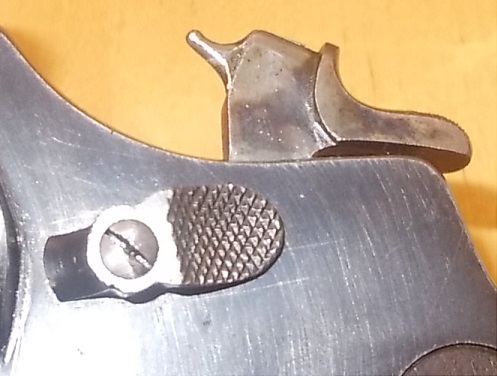
Interestingly, Trocaola chose to keep the pivoting firing pin nose of the S&W, which they could quite easily have done away with as a manufacturing shortcut. Surprisingly, they used a flush-ground solid pin rather than the rollpin of the original, which is so well-fitted that you can hardly see it in the photograph.
Viewed now from above, we have an ergonomic feature that is clearly better than the original S&W:
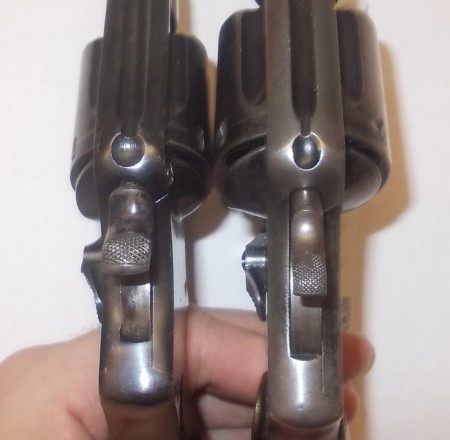
The S&W hammer of the era, which is the same even on the WW2 M&P in the first picture, is made of a single slab of steel, and has the same thickness everywhere. The hammer spur on the Trocaola (left) is broader than the body of the hammer, making manipulation rather easier – even though this is a manufacturing complication! Like the S&W, the hammer is colour case hardened. You can also see from this photo that the sideplate fit is pretty good. Although you can tell that the S&W is made to higher tolerances than the Trocaola when you put it back on, since the Trocaola is quite tight.
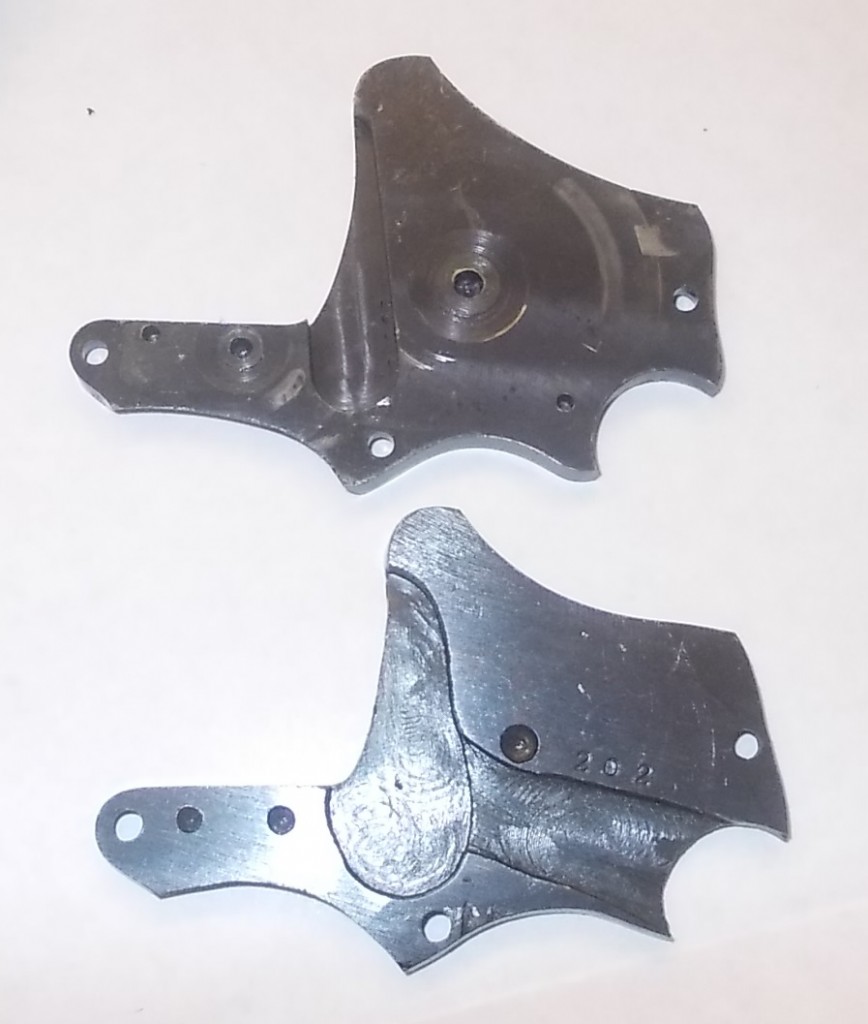
Here we can see a major manufacturing shortcut – the cutouts on the inside of the sideplate on the Trocaola (bottom) have clearly been made with worn tooling, cut as fast as possible. But since they don’t come in contact with any moving parts, it doesn’t matter. Interestingly, the three digit number stamped on the sideplate is not part of the serial number, but appears also on the front face of the cylinder and under the barrel. The crane and the bottom of the grip frame carry the real serial number.
Another change is the ratchets:
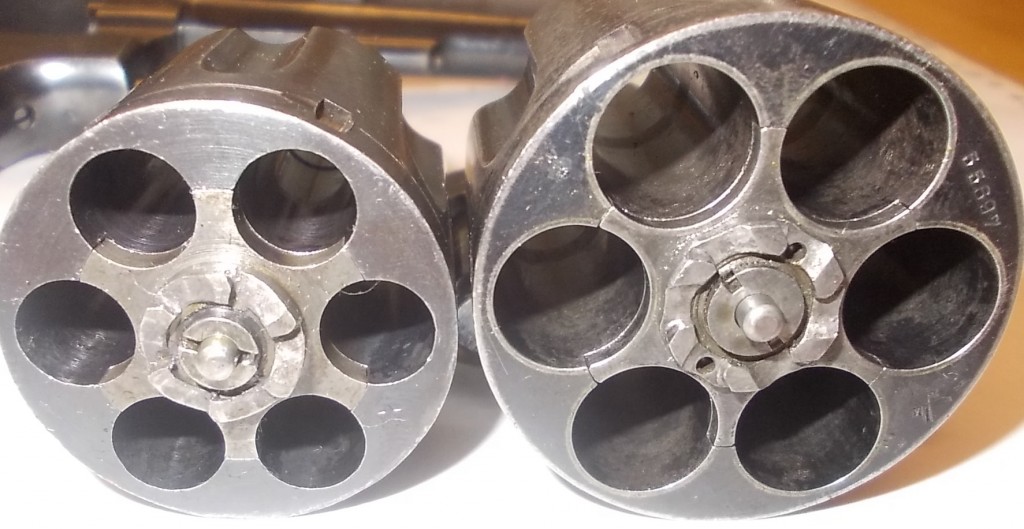
The Trocaola ratchet (left) is much simpler, and much more rugged. It is also quite a lot thicker, to compensate for the comparatively soft metal used in the revolver’s construction. And the rumours about soft metal are true – the screws in particular are made of monkey metal, and the sideplate has a slight dent where someone (not me!) hit it too hard with something too pointed when putting it back on!
To go with this chunkier ratchet, the hand is also much thicker and more rugged:
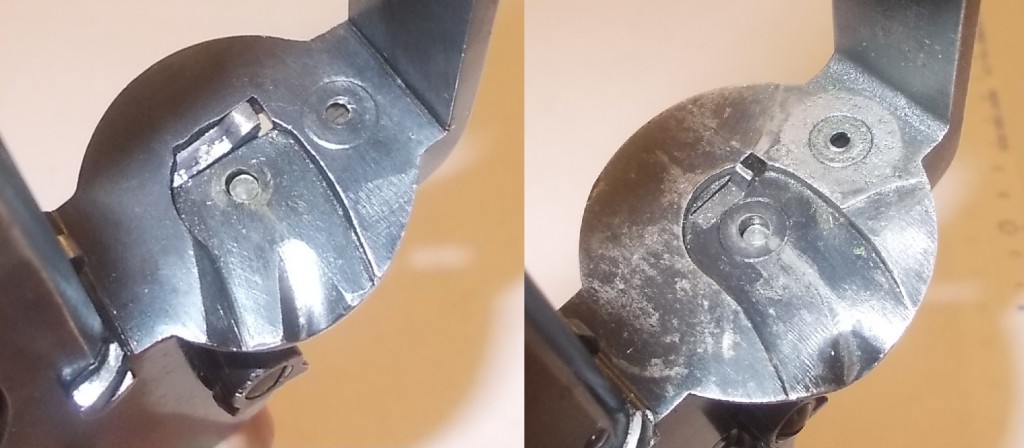
From a military standpoint, the S&W hand is quite fine and relatively fragile – the British Textbook of Smallarms makes reference to the S&W having the finest and most fragile lockwork of the three main British service revolvers of the period (Webley, Colt, S&W). From this perspective, the Trocaola hand is much stronger, much more rugged, and can thus apply more force to the ratchet in case the revolver is full of mud. You can also see the deep cutout in the recoil shield to allow the thicker ratchet to pass.
At the other end of the cylinder we have another bit of ruggedisation. The forcing cone is long, and gently tapered. Bearing in mind that the bore is .327”, here’s a .361” bullet inserted base-first into the forcing cone:
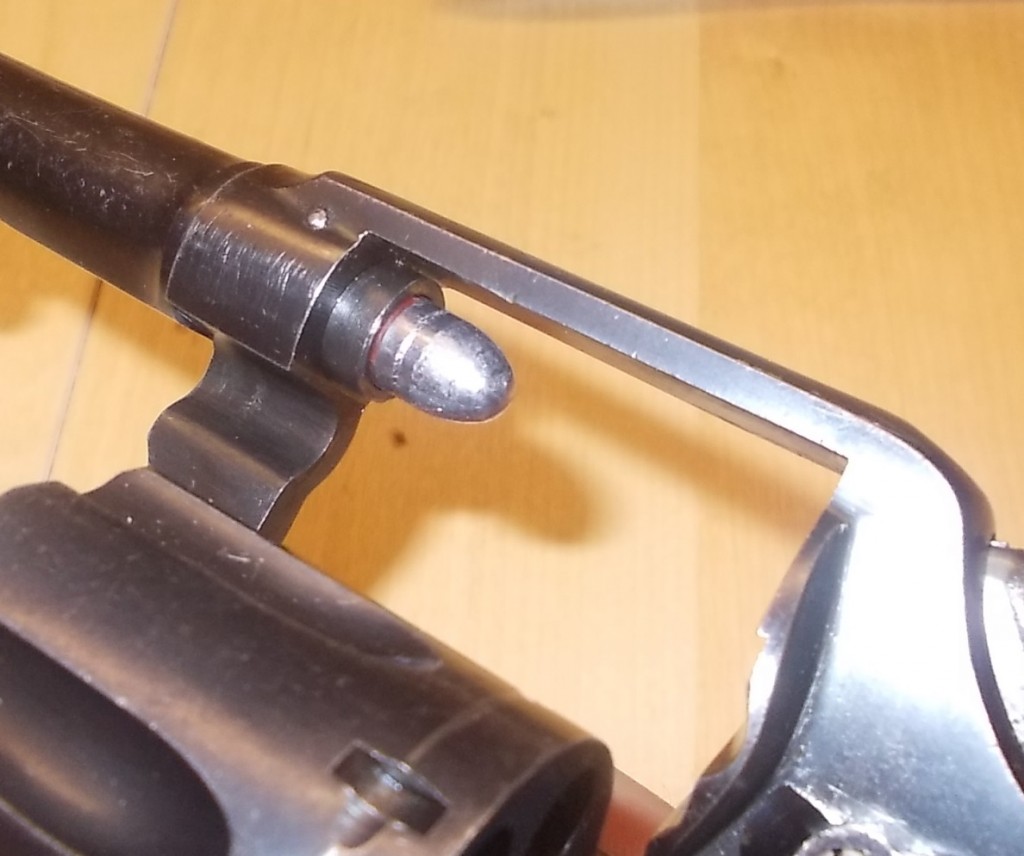
This will tolerate enormous amounts of mud and fouling, as well as an incredible misalignment of the cylinder. The flash gap is .017”, about the same as the Hand Ejector (.015”), but much less than the later commercial M&P (.007”). Again, we’re going for reliability and tolerance of dirt here.
Let’s take a look at the lockwork now:
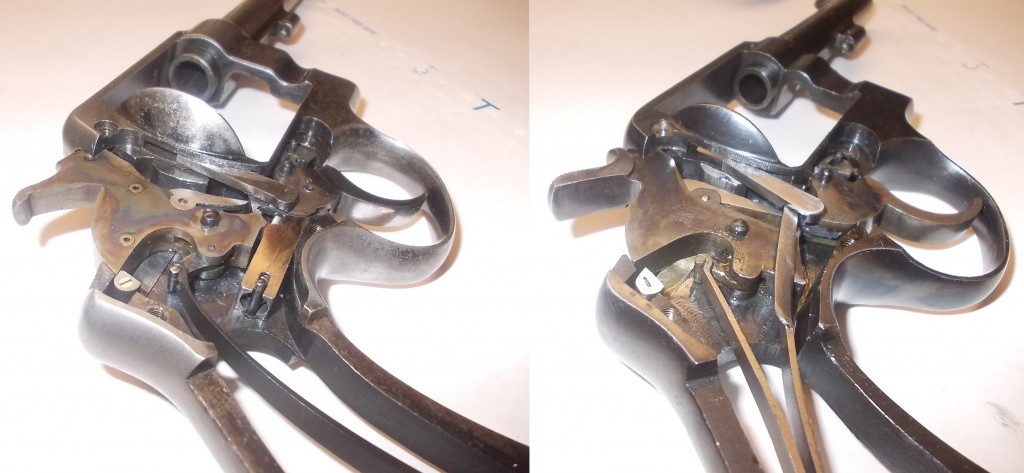
This is where it gets really interesting. On the left we have the classic S&W lockwork of the period, and on the right we have the extremely well-rationalised Trocaola lockwork.
The first thing you’ll notice is that the Trocaola is much simpler – there are only three major moving components: the trigger, the hand and the hammer. The trigger return slide has been deleted, reducing also the need to finely machine and finish the surfaces on which it runs. This removes quite a lot of parts and machining, since the trigger return slide also needs a post, a coil spring, and a connecting rod linking it with the trigger.
The mainspring is a single V-spring, which replaces three separate springs in the S&W: mainspring, trigger return spring and hand spring. One end of the V-spring is hooked onto a stirrup on the hammer, the same as the S&W. The other end terminates in a long finger which bears on an angled slot cut into the left face of the hand, pushing down on it. Since the slot is angled, this simultaneously pushes the hand down and cams it forward, and also pivots the trigger forward.
The parts are case-hardened where necessary, and the finish is every bit as good as the S&W where it matters. For ease of production, this rationalisation of the lock is very well thought-out.
Unfortunately, I can’t disassemble the lockwork further. That V-spring is a beast, and I suspect you need a clamp to un-tension it and take the lock parts out. But in any case, we can have a look at the lockworks in the resting and single-action positions (apologies for the camera glare):
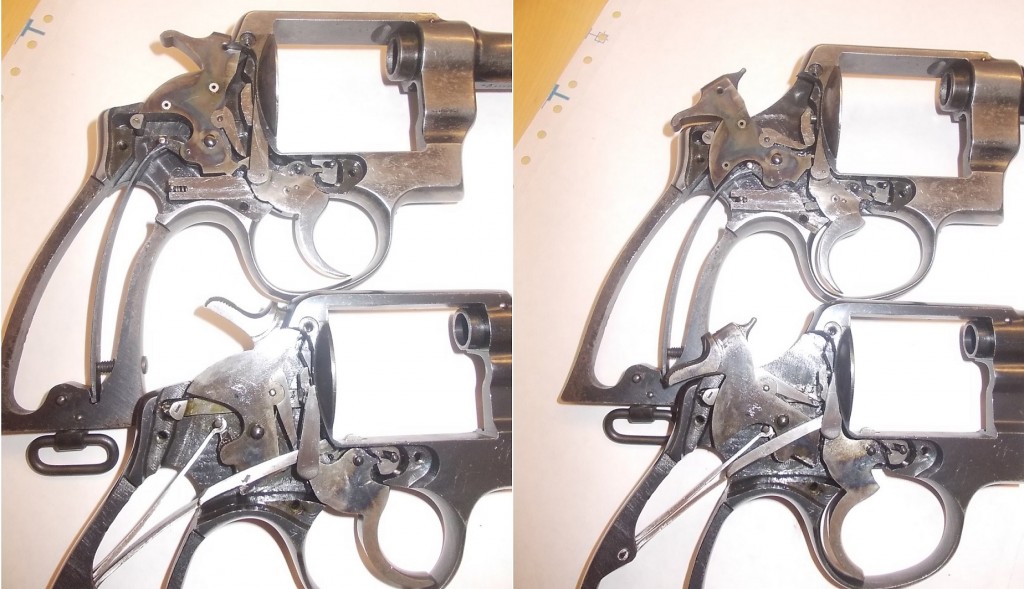
The Trocaola lockwork thus functionally does everything the S&W’s does, but with far fewer components and far less precision machining and function-critical finishing. The hammer even withdraws properly when the trigger comes forward, without the benefit of the lug on the trigger return slide. The revolver is thus equally as safe to carry with the hammer down on a loaded chamber as the S&W.
You’ll also notice a rollpin on the grip frame. This doesn’t go all the way through the mainspring, but simply serves to keep the fold of the spring in position.
Something else they could have scrimped on but didn’t is the cylinder stop spring, which is still inserted down an angled bore from the outside and closed with a screw. Later S&W’s did away with this.
However, all this ruggedisation and simplicity comes at a cost:
Trigger pull. S&W are not stupid, and they put all that complexity and fine metalwork into their triggers to give an excellent pull.
With the Trocaola, the double-action is smooth, predictable and somewhat heavy. In fact, it is even a bit lighter than the 455 Hand Ejector with its original spring which is quite stiff. One improvement though is that there’s less “trigger stack” towards the end of the pull than the S&W.
Single-action – they’ve gone for a bit of safety, and the single action is quite long and creepy, and heavier than the S&W. They’ve cut a clear notch in the hammer, and you feel the hammer moving back during sear release. For a mass conscript army, this is probably not a bad thing. There apparently used to be a prejudice in the British army of the period that handguns were of more danger to their users than to the enemy, and there is probably more than a grain of truth to that assertion.
Both trigger modes are heavier and longer than my war finish Webley 38 Mk.IV. But if we compare them to contemporary Continental revolvers, are they bad at all? I’ve never handled a French Model 92, but compared to a Swiss M1882, the pulls on this Trocaola are lighter, although the M82 single action is crisper – it’s just extremely heavy. Unfortunately, as a modern shooter there’s not a lot you can do about the trigger pull. If I could find a replacement spring, I might try filing it a bit thinner across its width, but I suspect that the way the spring interracts with the hand to cam it forward needs it to be fairly fierce.
Compared to a tuned S&W, it’s clearly an inferior product in handling. But this is somewhat unfair, since it was designed as a cheap, mass-produced combat arm that had to be reliable in the hands of a muddy conscript. As for interchangeability with a real M&P, there is none. Not even the grip panels – the half-moon cutouts are a different size, the alignment pin is in a different place, and the grip needs a hole for the mainspring pin.
Overall, it appears that the revolver is a very serviceable military handgun, certainly in comparison with its continental contemporaries. It is certainly more practical than the side-gate loaded Swiss M1882, even if the quality of the materials and the finish is understandably poorer. However, the materials and finish are good where they need to be.
If anybody wants any detail photos of any specific aspects, let me know – I’ll be happy to oblige (if it can be seen without taking the mainspring out!)

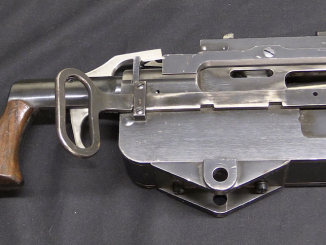
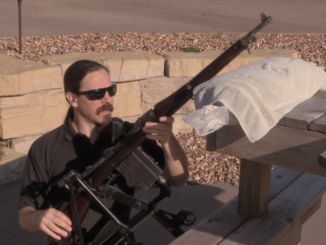
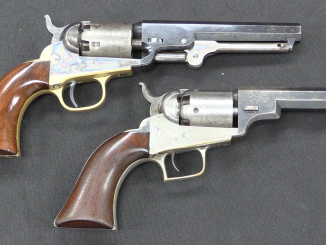
Thanks to Author and Ian for this post. Spanish swing out SW copies are always better quality than expected and Mr Burns article also proves this. However, there might be some points to remember and notice;
– Most Spanish small parts of that era like hammers were formed through casting. This might be the cause of multi thickness at hammer and some dots over the surface support this. These parts are subject to breakage especially at dry firing. Cost saving was the main purpose of course. Swing out cylinder safety gap at under the hammer dust cover arc also is a clue that all hammers are cast as standard sized and filed to fit to the particular revolver. Comparing same clearance with SW’s shows the huge tolerances.
– Multi function main spring forcing hammer and trigger through rotating hand was
a common application of Belgian revolvers like Galand, Francotte, Fagnus and others and licensed by Colt from there. Using the different, multi piece forcing sources was compulsory for SW not to fringe the Colt’s patent or at least not being similar.
– Thin extractor stars supporting only the thick web at end of round case is a safety feature or in other case, some rough tolerances between the cylinder counter face would cause shell tear or cut. Worn recoil shield by usage and time also causes such a issue through recoil.
– A pin point tweezer with double side sticker band rolled around may be used to take the “V” shaped mainspring out. In case of the cylinder rotate hand to be rolled back and slided out of its recess, the dismounting may be done even by bare fingers.
Thanks again for this excellent post.
I just figured out that what my father gave me is a Trocaola based on the article. It has a serial number of 8004 and appears to be In relatively good condition. I know little about hand guns and I’m curious if the low number matters much. Any thoughts would be appreciated.
These guns show up all the time at french gunshows in a rusted shut condition(unrestorable) Quite a few were brouht back from the first war and then hidden during ww2 When the germans told the population to turn in their guns they hid them I’ve seen guns that were hidden under manure piles What that does to soft metal is very interesting
French issue revolvers are marked with two stars. Spain copied the S&W Top Break in .44 Russian, 11mm French M73, 10.4 mm Italian and .455. These saw widespread service in WW 1 and the conflicts that followed. The French had copies of their M1892 revolvers, near copies of the M 1892 (usually marked 1915) copies of the S&W hand ejector (with a hammer that had a thick spur) and the Colt Police Positive. There were chambered in 8mm French and were well regarded. As an emergency measure The French simplified their holsters and even fabricated one for the 92 Spanish out of cloth. Like the Ruby pistols these revolvers served France well in the trenches of WW 1. Post war after a massive rebuild program many of the 8mm Spanish revolvers were retained for police and reserve duty.
How does the internal mechanism of the Trocaola compare to a Ruger or Charter Arms DA revolver? Or a Rossi or Taurus, for that matter?
Using modern investment casting, sintering, CAD/CAM and somewhat better materials, you could build these revolvers cheaply enough to be competitive and they’d still be perfectly safe and effective.
Since one of the big problems of the handgun industry for the past forty years has been “how do we make quality double-action revolvers that can be sold at an affordable price?”, I’d say the Trocaola and its brethren deserve a second look from everyone. Especially the likes of Colt and S&W.
cheers
eon
For a “cast Smith clone” you could be talking about the Philippine-made Armscorp .38s imported by Rock Island. Haven’t heard much about them but the cast-receiver Armscorp/ RI 1911s seem to be one of the better deals on the market – not nearly the tight tolerances of a Kimber or whatever but just for that reason very reliable with all sorts of ammo and/ or built-up gunk. If I ever get another 1911 I’ll be looking close at the RI 9mm – not to get into the lunatic “9 vs. .45” debate (I’d hate to get shot with either, and the same for a .22 short!) but the most fun I ever had with a 1911 was a 9mm Colt Commander a buddy had back in the 80s when the cheap-but-good Korean ammo was using low prices to establish an American market, and we killed the bank of the pond on the back side of his farm several times over!
Externally these look like S&W, but internally they are Colts. And like Colts, they may appear to be simpler than S&W’s, but in truth trying to get one in time or to fit a new part can reduce a grown man to tears. They are a design for a place or for an age when skilled labor is or was cheap.
A lot of these showed up in the US post WWI (not surplus, but made for export). Some had “for S&W ctg” stamped on them, with the S and the W a lot bigger than the for and the ctg. They were inexpensive but had a bad reputation as they would wear from the soft steel then replacement parts were impossible to get and more impossible to fit and get everything in time. It seems like S&W felt it’s trademark was being damaged and eventually had shipments confiscated.
Great article, thank you Mike!
A side note: interestingly the muzzle energy of the Mle 1892 is nearly identical to the M1873-90 loading for the Mle 1873 revolver (145 ft-lbf), indicating that the French must have been satisfied with it. It was somewhat more potent than typical .32 S&W Long loadings, so it wasn’t terribly anemic by the standards of the day.
Officially used revolvers with French punches were, as far as I could find out:
– Aguirrey_Y_Cia copy of S&W with simplified lockwork
– Antonio_Erasti copy of the Colt Army Special
– Aranzabal copy of S&W with simplified lockwork
– unknown company (possibly Arismendi) copies of Nagant 1910 (right-side ejecting 7-shot cylinder w/o gas seal)
– Brichet “Constabulary” type revolver
– Garate copy of Colt Army Special
– Orbea_Hermanos copy of M&P with simplified lockwork
– TAC made revolver (mix of Colt, S&W and local ideas)
– Unceta_Esperanze_Y_Cie revolver with cylinder release on the crane (same as Grah and Pieper-Bayard revolvers)
– Very few copies of few Mle.1915 (same as Mle.1892 but with left-side cylinder ejection) by unknown manufacturer.
Some of those revolvers (TAC, Garate, Aranzabal for sure) were also supplied to Romania. There was a popular comic (and movies) about Romanian police inspector Miclovan where he carries Garate made revolver (recognizable due the grip angle).
http://images61.fotki.com/v665/photos/5/103795/12714931/DSC01597-vi.jpg
He also carried Dimanchea revolver, and main antagonist in one had two (nickeled) Steyr 1912… 🙂
http://www.mycity-military.com/imgs3/212275_99621188_Miclovan_comix.jpg
British supplied .455 Spanish copies of S&W breakdown also (I have seen two).
When Serbian army was reformed at Salonica some of those revolvers were supplied (main handgun supplied were Ruby pistols, but there were also revolvers, both Mle.1892 and Spanish ones). No idea which ones were supplied as local sources only list them as “Revolver, M.92, spanski (Spanish), 8mm”, but I have seen examples of Aguirrey Y Cia, Aranzabal, Garate and Brichet.
On the other side of front, I have also seen example of a Spanish (Garate) S&W breakdown in .44 Russian with Bulgarian markings. I have no idea if it was a capture from Russians, or they actually ordered those or it was a private purchase by some officer…
“F***’em if they don’t get the joke”… 😉
I inherited a revolver with S&W stamped on the barrel and no other markings other than a serial number on the bottom of the grip. It is in .22LR with a 6 inch barrel. Externally it looks just like the Smith you are displaying in these photo’s. But!!! Internally, the mechanism looks exactly like this Spanish example you are showing. The hammer V spring on mine broke about a year or so ago and I haven’t been able to find a Smith spring that looks the same. I have had gun smiths look at it before and I have never had one tell me that my gun might not actually be a Smith & Wesson. I told a gunsmith who my father in law knows well that I didn’t think it really was a Smith because it didn’t have the intertwined SW symbol. He assured me that K frames made around the time of the world wars didn’t have this symbol because it cost to much time and money. So I assumed I was in the wrong on that.
I would be very interested if someone out there has any info on .22LR’s that are some how related to this era and type of mechanism. I would really like to get mine working again. Thanks
In the photographs the Trocaola’s wide rear sight notch seems to be noticeably offset to the right. I wonder if the width is less a design feature than an artifact of a second, wider cut to regulate the sights. Have you been able to shoot it? If it does shoot to point of aim with the offset I think it would be safe to assume that the large notch was a corrective measure after it was test fired and the width necessary to cover the original cut.
It’s hard to tell for sure from the picture, but to me it seems that the camera was just not perfectly level and straight to get a correct sight picture.
@Goyo – it’s devilishly difficult to take this type of photo (I was amazed I managed to get 3 reasonable ones), and if you look at the hammer, you’ll see that camera’s not quite straight and level. Since the notch is curved, there’s no question of enlarging it one way or the other, and Trocaola wouldn’t have taken the time to do so anyway. Remember that in this era, not every European power had fully got on board with the idea of individually sighting every *rifle* at the factory (let alone sighting it to an individual soldier – probably only the British and the Swiss did so at that time), so the idea of individually sighting a revolver would be a bit strange to them.
I’ve in fact not had a chance to shoot it yet. This evening I have trimmed 12 cases from .32-20, and I shall try to shoot them as an opportunity presents itself. By the way, these revolvers will chamber .32 S&W Long, 7.5 Swiss revolver, and .32-20, although there’s really no point 🙂
Otherwise, to all – thanks for the comments. I’m looking for literature on these revolvers, in any language, so if anyone has any pointers I’d be grateful. I have also discovered where there’s an Orbea 8mm in good condition, so that may be the next to advance the collection.
.32 S&W Long should be safe to shoot, since it’s a lower pressure cartridge than 8mm Lebel (yes, that’s the official C.I.P. name of it). The bullet diameter is too small, though. 7.5 Swiss Ordnance on the other hand is a much higher pressure cartridge and firing for example the modern Fiocchi loads with those old guns is not safe.
Fiocchi of course still makes even actual 8mm Lebel ammunition (don’t know if it’s imported to the US), which incidentally is a considerably hotter than the 120 grn @ 740 fps mentioned by you and many other sources; 111 grn @ 886 fps for 193 ft-lbf. This leads me to believe that the former numbers are for the original black powder load.
Fiocchi has to follow C.I.P. specs by law and C.I.P. of course has not invented them from thin air: in case of old military cartridges for weapons no longer in production they are based on the original military loadings. So, probably the French smokeless powder military loading was closer to the modern Fiocchi loading than the black powder loading. I admittedly don’t know when the smokeless load was introduced, but presumably before or during WW1(?). I do know that the Mle 1892 revolver was used by French gendarme and police until early 1960s! A pretty long career for a 19th century handgun.
Att. Mike Burns:
I just read your article, “Eibar “Spanish Model 92” Revolver” and wish to thank you for it. I have a few S&W Hand Ejector Mk 2 revolvers, but have never seen the Spanish copies (Eibar) . Your pictures of the revolvers are great!
Only one of my H.E. Mk II’s shoots well. It has a good deal of nickel in the steel , so I polished it up and it looks like nickel plate , although it will rust if you don’t keep it oiled or waxed. It shoots very well for me with 45 ACP (the rims of which I squeeze at 12,3,6 and 9 o’clock to make them act like semi rimmed brass. They shoot very well at around 800 fps . At 25 meters I can hit a 5 inch bull 4 out of six shots standing unsupported.
We don’t have Mil Surp handguns up in Canada like you do in the states. I was lucky to get the other two hand ejectors for parts as they are non
functional . (one assembled wrong ,the other bullet tumbles at 25 meters.)
Thanks for the article.
Hi Mike I have a 1926 Eibar 32 cal pistol. what do you think its worth.
I have one in 38 special ctg.
Actually this is closer internally to some of the turn of the century S&Ws. Here are a couple sorely mistreated samples that I was able to look at recently.
This is a very early .32 Hand Ejector that apparently was factory renickled at some point, then someone cleaned up some pits with a file and then spraypainted with ?BBQ pit paint? ?
http://www.fototime.com/B2D07B6B8F5EF1E/medium800.jpg
Here is a pre1900 1st Model M&P that has had some creative repair work done to it and reblued at some point.
http://www.fototime.com/DB61531C8ECF1D4/medium800.jpg
Thanks! Here are a few more.
http://www.fototime.com/940D7224F11FE56/xlarge.jpg
http://www.fototime.com/0BFC1A16408AFEF/xlarge.jpg
http://www.fototime.com/833997E0077FF45/xlarge.jpg
I have a Spanish, 1925 to 1927 38 CAL long ctg,Revolver 5 in.
Bal. 6 Shot, I have cyl. Timing, problem, miss, aliment,
Problem, with cly.
I have read, you can, replace the hand and spring,
Does, any one have any,advice, I would to this
Revolver, into a match round, shooter,
Does, anyone, have,any advice, on the modifications,
It would, take to turn the firearm, into,a world
Class,item.
Thank you for your time and consideration in this effort
Alalthekittyspal
I recently inherited one of these in .32 and while the quality appears excellent the metal seems soft. The barrel on mine was canted to the right. I thought it was a manufacturing error but the frame was actually bent. I put the frame in a vice block and was able to bend the frame straight with one solid whack from a dead blow hammer applied to the right side of the barrel. I see no cracks or damage so I intend to carefully fire this with light handloads to see if the condition reoccurs. It’s possible it was caused by physical abuse or being fired out of time or with a bore obstruction or a magnum cartridge.
Does anyone know where I can get both an exploded diagram for a 32 cal Eibar as well as parts? Thanks.
Does anyone know were I may find a hammer for a 44 Spl?
I would love to get it fire ready !!
I have a38 long cartridge looks to have a 3 digit serial number how can I find out the age of it or the vaule thanks for any help if need to contact me for any other questions email me at daddysharleyrose@gmail.com
I inherited a Tracola 38long CTG 4 Eibar1926 Cat 38, #730.
I would appreciate obtaining its value in today’s market.
It has a lion stamp on the barrel and the letters “PM” with a crown court shield stamped on the main housing.
.
I have a tracola arms revolver. I have been shooting 32-20 rounds in without any problems. Just made a pruchase of orginal 8mm rounds made by Fiocchi from Buffalo Arms. Can’t wait to try them out. My dad brought the revolver back from France in 1945. He said he took it off a dead German officer at the Battle of the Buldge along with a Geman Flag off a tank. (At least thats the story he tells.)
I have an Eibar Spanish 92 but I need parts. Does anyone know where I can source parts? Thanks.
I have a Tricola including the holster and belt for sale if your interested. The outside condition isn’t the greatest and the cartridge drum does not stop on the breach opening correctly from wear but it is complete. Looking for offers if you or someone you know is looking for one.
What Parts are you looking for? Mine broke the V Spring, so I have two options, I either buy a new spring (probably have one made) or sell the rest of the pieces
Does anyone recognize this Spanish 32 revolver trade mark?
I have a Tracola arms revolver as well. Have to repair it, but can’t find a place with a good choice of spare parts. Joe from Tennessee, how much do you want for yours?
I was told by a pawn/arms dealer. He did a short search on the net( I’ve sold to him before) and he told me its worth is in the 100 dollar range + or -, to a collector but he did not have anybody who he deals with that would be interested. He told me to check online, so that’s how you found me. I inherited it, hung it on the wall for a number of years, and lost interest. I have no pressure to sell, just thought someone with a collector’s interest might want it. I’m not sure how to sell/transfer since I need to be sure it does not fall into the wrong hands.
I have one that is in nickel. A 32 seems loose in the barrel. If anyone could tell me anything about this revolver. It would be greatly appreciated!!
I just bought a spanish S&W copy. It is in very good condition mechanically and finish wise, about 98%, very nice grips which fit perfectly slightly pitted bore, marked 38 long cartridge. Front sight S&W style half moon, rear half circle, which the front sight fills completely. Seems to have front sight canted slightly right. Barrel pinned to the frame, four screws in the frame side, one for the hammer, three below the cylinder cut out on the frame, and one in front of the trigger guard. NO REMOVABLE SIDE PLATE. Everything inserted thru the removable trigger guard ALA H&R. breaktops. Case hardened hammer & trigger. Three digit serial number only on the grip bottom & made in spain so small serios magnification needed to read. Let me know if you can anything you know about it. Much thanks.
I have the same one and need to know how to take it apart as nd put it back together. If you manage to come up with any information about it, could you send it to me? It would be super helpful. My email is jtwhite3825@gmail.com
I have a 8mm that look like a smith 38, On the top of the barrel its marked 8mm calibre. Serial #37813 and on the side by the hammer is an emblem of what looks lke a police badge on the top the word Trade and the bottom Has MARK. Which 8mm ammo does it use?
I am in need of a little help… I have a eibar 32/20 ctg that has been passed down. Im 3rd gen to have possession of the firearm. Aaaand here is my conundrum.. While I am fairly proficient at taking rifles and pistols apart (newer firearms) in haste i made a grave mistake. I didnt take my firearm apart on a mat. Instead… On my lap in bed… While having a drink. (Being honest here). I was confident i knew how to put back together… A gross misstep on my behalf. Since i was a boy it only worked single action… So i wanted to try and repair. I F*×$ed up. Can anyone let me know a website with illustrations that may help? And/ or a website that still sells parts for these firearms. Everywhere i have looked i have come up very short. Thanks in advance.
Mark
markwinterling4268@gmail.com
I have a Tracola arms revolver as well. Have to repair it, but can’t find a place with a good choice of spare parts. Joe from Tennessee, how much do you want for yours?
Alex. I saw your old post from 2020. I have a Trocaola Aramzabal Y Cia, Model 92, 32-20 for sale. I have not fired it in over 12 years…worked then. if still looking text me at 804-939-2580. Thanks. L.B.
YOU CAN FIND TROCAOLA ARANZABAL S&W STYLE V SPRINGS AT DIXIE GUN WORKS, INK. $6.95. I NEED A HAND OR A FOR MINE. 1 WOULD SETTLE FOR A BROKEN ONE TO USE AS A PATTERN TO FABRICATE ONE. ANY SOURCES OUT THERE? THANKS. JTW
Thank you very much for your post. It is very interesting. This gun is a good unit and some french officers have replaced the MAS 1892 for it . Becaus it was like american guns.
For me it was better for the war as MAS 1892;
Sorry for my english, i am french
I have one that is in nickel. A 32 seems loose in the barrel. If anyone could tell me anything about this revolver. It would be greatly appreciated!!
I just received a “Smith and Wesson” from the last RIA auction, and as I looked it over, then searched for V-spring information, I found this article. I tried a 32 Smith and Wesson Long in it, and it is certainly 8MM Lebel. I did not pay much for it, but am disappointed it is not a Smith. I bought it to practice my gunsmithing, but what market is there for Eibar work – LOL.
I would realy like to know how one of these trocaola’s guns came to be with my great grandfather in brazil.
Any idea where I could find a mainspring for the Eibar .32-20? I’ve searched and searched to no avail 🙁
Seem that the main V spring is a common fail. My father has one as well from my great grandfather and I’ve looked for many years. If anyone finds a supplier that would be a great share
Thank you for this site and article. I have a Spain copy of 38 spc. No mfg markings and great chrome. But after purchase the firing pin was too short. Well it’s a hammer pin and partly Broken off
The pictures in the article show what appears to be a one piece hammer with intrigal pin
So I may have a rogue hammer that is nearly impossible to get the v spring back in place.
Can anyone help with hammer or just hammer pin to restore functionality, please?
I’m still looking for that mainspring 🙁
An S&W M&P/early Model 10 K frame piece works fine…Look up K frame hammer nose, they run about $10… fixed a .38L Eibar with H&R style lock work last year.
Thanks Jeff but I need the mainspring for a .32-20, not a .38 🙁
The article and several folks here mention that the steel used for these Spanish replicas is weaker. I have an older GAC 38 Long and I’m trying to determine the type of metal the frame is made of. I’m guessing that if these are not hard steel then they’re likely not 4140. It doesn’t look like cast metal however, is it mild steel? Does anyone know? A spark test is not helping me much on this one. Thanks everyone!
I have what’s appears to maybe one of the last ditch rifles but not Shure ifs not a crudely made weapon but some of the features are on the last ditch vidio you made the but the quiltie is pretty nice made gun but only markings i\on the rifle look like f i r and under that is a b and in the serial number is pc and 5 digit serial number but I’m not Shure it a f i r they might not even be English letter they look more like Greek number